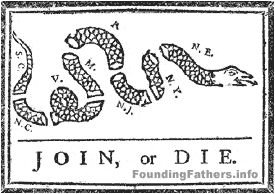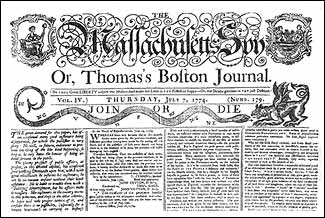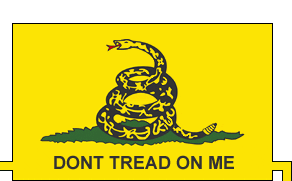Rattlesnake Flags & Early American Snake Symbolism
Join or Die
Benjamin Franklin is famous for his sense of humor. In 1751, he wrote a satirical commentary in his Pennsylvania Gazette suggesting that as a way to thank the Brits for their policy of sending convicted felons to America, American colonists should send rattlesnakes to England.
Three years later, in 1754, he used a snake to illustrate another point. This time not so humorous.
Franklin sketched, carved, and published the first known political cartoon in an American newspaper. It was the image of a snake cut into eight sections. The sections represented the individual colonies and the curves of the snake suggested the coastline. New England was combined into one section as the head of the snake. South Carolina was at the tail. Beneath the snake were the ominous words "Join, or Die."

Benjamin Franklin's woodcut from May 9, 1754.
Newspaper Serial and Government Publications Division,
Library of Congress.
|
This had nothing to do with independence from Britain. It was a plea for unity in defending the colonies during the French and Indian War. It played off a common superstition of the time: a snake that had been cut into pieces could come back to life if you joined the sections together before sunset.
The snake illustration was reprinted throughout the colonies. Dozens of newspapers from Massachusetts to South Carolina ran Franklin's sketch or some variation of it. For example, the Boston Gazette recreated the snake with the words "Unite and Conquer" coming from its mouth.
I suppose the newspaper editors were hungry for graphic material, this being America's first political cartoon. Whatever the reason, Franklin's snake wiggled its way into American culture as an early symbol of a shared national identity.
American independence
The snake symbol came in handy ten years later, when Americans were again uniting against a common enemy.
In 1765 the common enemy was the Stamp Act. The British decided that they needed more control over the colonies, and more importantly, they needed more money from the colonies. The Crown was loaded with debt from the French and Indian War.
Why shouldn't the Americans — "children planted by our care, nourished by our indulgence," as Charles Townshend of the House of Commons put it — pay off England's debt?
Colonel Isaac Barre, who had fought in the French and Indian War, responded that the colonies hadn't been planted by the care of the British government, they'd been established by people fleeing it. And the British government hadn't nourished the colonies, they'd flourished despite what the British government did and didn't do.
In this speech, Barre referred to the colonists as "sons of liberty."
In the following months and years, as we know, the Sons of Liberty became increasingly resentful of English interference. And as the tides of American public opinion moved closer and closer to rebellion, Franklin's disjointed snake continued to be used as symbol of American unity, and American independence. For example, in 1774 Paul Revere added it to the masthead of The Massachusetts Spy and showed the snake fighting a British dragon.

Paul Revere's modified "Join or Die" snake from the masthead
of Thomas's Boston Journal, July 7, 1774. Newspaper Serial
and Government Publications Division, Library of Congress.
|
Note: This history of the Gadsden flag was written by me, Chris Whitten, based on extensive personal research. It also appears on FoundingFathers.info. You are welcome to quote from it, reprint excerpts, or even republish the entire thing. However, please give me credit and link to Gadsden.info. If you want to copy images, see the Gadsden flag clip art page. Thanks!
|

